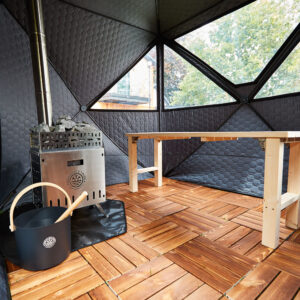
Ice Baths: A Key to Enhanced Recovery and Vitality for Athletes
Explore how ice baths can boost recovery and enhance vitality for athletes. Discover practical tips and insights to elevate your performance. Read more!
Spend Over £500 To Get Free UK Delivery - Excludes Certain Postcodes & Round Ice Baths
Delivery to Ireland now available

Ever had a throbbing headache and wondered if a warm shower would help? You’re not alone. Science says showers can, especially for tension headaches. The warmth makes your blood vessels expand, relaxing muscle tension. But that’s not all. Join us as we explore how the right shower temperature, essential oils and even how you breathe can amplify the benefits.
Headaches are a common health issue that affects millions of people worldwide. They can be triggered by various factors, including stress, lack of sleep, dehydration, and certain medical conditions. Understanding the type of headache you’re experiencing is crucial for effective relief.
Tension headaches are the most common type, often described as a feeling of tightness or pressure around the forehead and sides of the head. These can be triggered by stress, poor posture, or even too much caffeine. On the other hand, migraine headaches are more intense and can be accompanied by symptoms like sensitivity to light and sound, nausea, and vomiting. The exact cause of migraines is still a mystery, but unusual brain activity and blood vessel function are believed to play a role.
Sinus headaches, another common type, are caused by inflammation or infection of the sinuses. These headaches often come with facial pain and pressure, making them particularly uncomfortable. Recognising the type of headache you have can help you choose the most effective relief method, whether it’s a warm shower, essential oils, or other relaxation techniques.
Warm showers can help with headaches by relaxing tense muscles and increasing blood flow through vasodilation.
Hot showers can relieve general headache pain but may worsen migraines associated with nausea.
Shower temperature for headache relief varies among individuals and depends on symptoms and triggers.
Essential oils like lavender can enhance the headache-relieving benefits of showers when added to the shower floor for steam diffusion.
Practicing deep breathing in the shower can further help relieve headache pain and relax.

You may be familiar with the discomfort of a tension headache, characterized by a tightness or pressure on your forehead and the sides of your head, but you may not know it’s the most common primary headache.
It can be triggered by too much caffeine or prolonged computer screen exposure.
On the other hand, migraine headaches are more intense and can be accompanied by symptoms like sensitivity to light and sound, nausea, and vomiting. Its cause is unknown but unusual brain activity and blood vessel function may contribute.
Recognizing the type of headache you have can help you choose the most effective relief method, whether it’s a warm shower, essential oils, or other relaxation techniques to alleviate migraine symptoms.
Both tension headaches and migraines can be managed through lifestyle changes and relaxation techniques.

Knowing your type of headache and triggers is the first step to managing your pain and finding ways to relieve headaches.
Warm showers for instance can play a big role in headache relief. The heat can relax tight muscles in your head, neck, and shoulders which often relieves tension headaches. This is called vasodilation increasing blood flow, relaxing muscles and reducing pain.
The increased blood flow even makes your muscles more elastic, reducing pain. Warm showers also can block pain signals. Your skin’s sensory receptors send pain signals to your brain but these pathways can be interrupted by warm temperatures.
Find the right shower temperature and you’ll be on your way to easing your headache discomfort. A hot shower will relax away achiness but if you have migraines with nausea it may not be suitable. Cold showers, on the other hand, can help reduce migraine pain by constricting blood vessels.

A warm shower can provide relief by relaxing and increasing circulation. Try both hot and warm showers to see what works best for you.
When choosing a shower temperature consider your individual needs such as nausea or sinus pain. Remember everyone is different what works for one may not work for another. For those suffering from sinus pain, the steam from a warm shower can help alleviate sinus congestion by thinning mucus in the nasal passages.
Steam can be just the ticket for relieving headache pain. When you step into a warm shower or bath, the steam works wonders by helping to relax tense muscles and improve blood flow. This can significantly reduce pain signals and alleviate headache pain, making you feel more at ease.
For those suffering from sinus pain, steam can be especially beneficial. It helps to loosen and clear mucus from the sinuses, providing much-needed relief from congestion and pressure. Adding a few drops of lavender essential oil to your shower or bath can enhance these effects. Lavender is known for its calming properties, which can help reduce stress and anxiety—common contributors to headache pain.
So, the next time you’re battling a headache, consider the soothing power of steam. Whether it’s a warm shower or a relaxing bath, the combination of heat and steam can help relax tense muscles, improve blood flow, and provide a therapeutic environment for headache relief.
Looking to enhance the headache-relieving benefits of your shower? Try incorporating essential oils. Certain oils like lavender essential oil can ease headache intensity.
Just add a few drops to your shower floor and let the steam diffuse the scent throughout the space. Not only will this provide a soothing aroma but also therapeutic benefits.
Lavender oil can alleviate sinus congestion and relax, which in turn helps with headache relief. If you’re sensitive to scents you can use fragrance-free soap.

While fighting a headache, especially if you experience migraine symptoms, you might find relief in the simplest of acts: taking a shower. Deep breathing techniques can help. As the warm water cascades over you take slow, purposeful breaths. Inhale the steam, hold for a moment then exhale fully.
This is a mini-meditation to distract from discomfort and relax. The steam itself is a natural byproduct of every hot shower and provides a therapeutic environment. It feels good as you breathe it in and out and reduces tension.
These relaxation tips along with the warm heat and steam can provide temporarily headache relief. Remember your shower isn’t just for cleanliness it’s a sanctuary for healing and relaxation.
Yes, showers can help with other physical ailments. They’re great for relieving muscle tension, aiding sleep and even boosting your mood. Try different temperatures to see what works best for you.
Take showers as needed for headache relief. There’s no one size fits all. Monitor your symptoms and take a warm shower when a headache starts. But remember it’s a temporary solution not a cure.
Yes, showers can work for all kinds of headaches. The warmth relaxes tense muscles which can ease tension headaches. Migraine headache sufferers may also find a warm shower comforting. But individual results may vary.
Yes, there are. Overuse of hot showers can dry and irritate skin which can be uncomfortable. Also sudden temperature changes can trigger headaches in some people so always adjust temperatures gradually.
Yes, showering at a certain time can help headache relief. Evening showers can help you relax before bed which can help with headache relief. But everyone is different so try different shower times to see what works for you.
So yes, showers can be your headache hero. Think of it as your personal spa retreat with warm water relaxing your muscles and essential oils adding a scent. Adjust your shower temperature and practice deep breathing to enhance the experience. But remember this is not a cure all. Seek medical attention if your headaches persist as they could be a sign of a more serious condition.

Founder of Urban Ice Tribe

Explore how ice baths can boost recovery and enhance vitality for athletes. Discover practical tips and insights to elevate your performance. Read more!

There’s nothing quite like the raw, elemental power of a pop-up sauna. Portable, authentic, and deeply restorative, it’s the perfect way to reconnect with nature and yourself. But to take your sauna ritual to the next level, the right sauna accessories can make all the difference.

Transform your outdoor space into a personal wellness retreat with the Urban Ice Tribe Sauna Tent. This detailed setup guide walks you through every step, from unboxing to your first steam session, blending practical instruction with the mindful ritual of heat therapy.
Helping men & women release anxieties & limiting beliefs to experience a life of freedom using powerful breathwork, cold water therapy, movement & sound healing.

No spam, notifications only about new products, updates, offers and announcements.